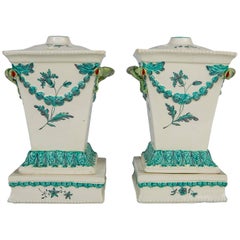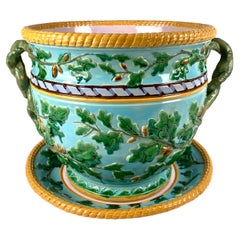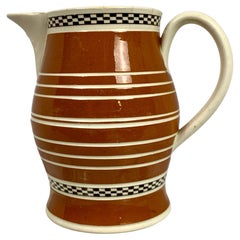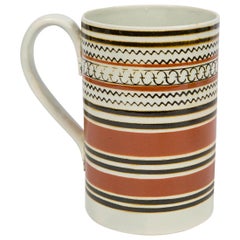Want more images or videos?
Request additional images or videos from the seller
1 of 8
A Mocha Ware Slip Agateware Loving Cup
$2,100List Price
About the Item
- Dimensions:Height: 5.5 in (13.97 cm)Width: 8.75 in (22.23 cm)Depth: 5 in (12.7 cm)
- Style:Neoclassical (Of the Period)
- Materials and Techniques:
- Place of Origin:
- Period:
- Date of Manufacture:Circa 1800
- Condition:
- Seller Location:Katonah, NY
- Reference Number:1stDibs: f86651508042822193fs
About the Seller
5.0
Recognized Seller
These prestigious sellers are industry leaders and represent the highest echelon for item quality and design.
Platinum Seller
Premium sellers with a 4.7+ rating and 24-hour response times
Established in 1962
1stDibs seller since 2009
493 sales on 1stDibs
Typical response time: 1 hour
Authenticity Guarantee
In the unlikely event there’s an issue with an item’s authenticity, contact us within 1 year for a full refund. DetailsMoney-Back Guarantee
If your item is not as described, is damaged in transit, or does not arrive, contact us within 7 days for a full refund. Details24-Hour Cancellation
You have a 24-hour grace period in which to reconsider your purchase, with no questions asked.Vetted Professional Sellers
Our world-class sellers must adhere to strict standards for service and quality, maintaining the integrity of our listings.Price-Match Guarantee
If you find that a seller listed the same item for a lower price elsewhere, we’ll match it.Trusted Global Delivery
Our best-in-class carrier network provides specialized shipping options worldwide, including custom delivery.You May Also Like
Country Life Pottery, Vintage Agateware Studio Pottery Vase, U.K., Circa 1977
Located in Chatham, ON
Country Life Pottery- Vintage studio pottery agateware vase - wheel thrown with clear glaze - original sticker to the base - vintage photocopy with history of vase...
Category
Late 20th Century British Victorian Vases
Materials
Ceramic
$375
H 3.25 in Dm 2.88 in
English Pearlware Blue Slip Pottery Mocha Mug
Located in Downingtown, PA
English Blue Ground Pottery Mocha Mug
Late 18th Century
The blue ground slip tankard with a white handle with leaf terminals has two bands of molded checkerboard black and white ba...
Category
Antique Late 18th Century English Georgian Ceramics
Materials
Ceramic, Pearlware, Pottery
19th Century Wedgwood Queens Ware Creamware Gilt Pitcher and Basin Set
By Josiah Wedgwood
Located in Lomita, CA
Queens Ware is the mark on this pitcher and basin set made in England in the mid to late 1800s by Wedgwood. It is also known as creamware, a techniqu...
Category
Antique Late 19th Century English Neoclassical Ceramics
Materials
Ceramic
$251 Sale Price / set
40% Off
H 3.5 in W 17 in D 17 in
Ceramic Vase Royal Doulton Chang Ware
By Royal Doulton
Located in Atlanta, GA
A glazed ceramic vase in slender spindle form from the Chang Ware series by Royal Doulton (England, founded 1815) circa 1920-30s. The vase was decorated with thick and dripping glaze in rich mottled polychrome colors. The glaze shows overall irregular crackles, a signature characteristic of Chang Ware. The base is hand-marked "NOKE", Royal Doulton in rectangle and initial HN (for Harry Nixon).
Developed by Charles J. Noke (1858-1941), Doulton's Art Director, as part of his experimentation into Chinese flambé glazes during the 1920s. Fired at very high temperatures, they were introduced commercially by Doulton in 1925 in response to popular demand for eastern style ceramics. They were applied primarily by Harry Nixon (1886-1955). The name Chang Ware was used by Doulton in reference to the possibly mythical Song potter, Chang the Elder, although it bears little relationship to Song ceramics.
Category
Vintage 1920s English Modern Vases
Materials
Ceramic
Small Transfer Ware Pot with Lid
Located in Los Angeles, CA
This exquisite early 19th-century chinoiserie box, adorned with lacquered surfaces and ornate gold-toned detailing, showcases the superb craftsmanship of English artisans influenced ...
Category
Antique 19th Century English Victorian Ceramics
Materials
Ceramic
19th Century Slip Ware Dish
Located in Bakewell, GB
19th Century Slip Ware Dish
In excellent condition
height 33cms x width 26cms x 4cms deep
Category
Antique 19th Century Ceramics
Materials
Ceramic
Beak Cup by Clayton Bailey, 1970
Located in Sagaponack, NY
A wonderful example of California Funk pottery: a hand thrown salt-glazed cup utilizing an expressive nose as a handle. Signed and dated BC 70.
Category
Vintage 1970s American American Craftsman Ceramics
Materials
Ceramic
Rare Doulton Burslem Luscian Ware Hand Painted Exhibition Vase, circa 1893
By Doulton Burslem
Located in Bishop's Stortford, Hertfordshire
An exceptional and rare Doulton Burslem Luscian ware tear drop shaped vase handpainted by renowned miniature and historical artist Leslie Johnson dating between 1891 and 1902. The ta...
Category
Antique 1890s European Aesthetic Movement Vases
Materials
Ceramic
$964
Free Shipping
H 11.82 in Dm 5.32 in
Royal Doulton Isaac Walton Series Ware Jardiniere by Charles Noke, Signed
By Royal Doulton, Charles Noke
Located in Soquel, CA
Large late 19th century stoneware jardiniere, a Royal Doulton Isaac Walton Series Ware piece by Charles Noke (English, 1858-1683). This large jardiniere has three handles and is decorated with several detailed figures; characters based on the 17th century English author Isaac Walton's book The Complete...
Category
Early 20th Century English Planters, Cachepots and Jardinières
Materials
Stoneware
Carlton Ware Art Deco Rouge Royal Lustre Mikado Pattern Pottery Ginger Jar
By Carlton Ware Ltd
Located in Bishop's Stortford, Hertfordshire
A finely made Art Deco Carlton Ware pottery Rouge Royal Mikado pattern lidded ginger jar dating between 1935 and 1955. The jar stands on a narrow...
Category
Vintage 1940s English Art Deco Jars
Materials
Pottery
$275
Free Shipping
H 3.94 in Dm 3.94 in
More From This Seller
View AllPair Creamware Vases 18th Century English with Turquoise Trim Circa 1780
By Neale & Co.
Located in Katonah, NY
WHY WE LOVE IT: One of our absolute favorites!
A pair of 18th-century creamware flower holders complete with stands and covers made in England by Neale & Co. was one of the finest 18th century English potteries. The entire composition is classically elegant. The flower holders are decorated with turquoise swags and delicately painted flowers. The tops are pierced for flower stems. The handles are made in a pair of entwined snakes painted in turquoise with bright red mouths. This flower holder could be used with the tops for individual stems or without the tops for a bouquet. All parts of the set have survived and remained together for the past 200 years.
History of Creamware:
Creamware is the name given to a type of earthenware pottery made from cream-colored clays from Dorset and Devonshire combined with calcined flint.
Creamware was first produced in England sometime before 1740. Foremost of the pioneers of creamware in the Staffordshire Potteries was Thomas Whieldon. He produced a wide variety of creamware. The young Josiah Wedgwood was in partnership with Thomas Whieldon from 1754-1759. When Wedgwood left to set up his own business, he immediately directed his efforts to develop creamware. Many of the Staffordshire Potteries, especially Neale & Co., learned from Whieldon and Wedgwood and developed their own excellent creamware products.
Dated: 1795 to 1810 Hanley Staffordshire...
Category
Antique Late 18th Century English Neoclassical Vases
Materials
Creamware
Large Antique Majolica Planter Made Circa 1880 Turquoise Ground & Green Leaves
By Minton
Located in Katonah, NY
This exquisite 19th-century majolica jardiniere and underplate by Minton was handpainted in Stoke-upon-Trent, Staffordshire, England, around 1880. This jardiniere measures an impressive 17" across the handles
it is adorned with a delightful design of green oak leaves and light brown acorns that stand out beautifully against the beautiful turquoise background.
The handles, in the shape of twisting oak branches...
Category
Antique Late 19th Century English Arts and Crafts Planters, Cachepots an...
Materials
Majolica
Antique Mochaware Pitcher Chocolate Brown Slip Decoration England Circa 1815
Located in Katonah, NY
Made in England circa 1815 this mochaware pitcher is decorated with bands of lovely milk chocolate-colored slip.
The color works beautifully with the unpainted creamware body of the handle and interior of the pitcher.
Just below the top edge, we see a band of black and white rouletting, and above the bottom edge is a similar black and white rouletted band.
Dimensions: 5.75" tall x 4" at the widest point
Condition: Very Good: two short hairlines of approximately half an inch are seen on either side of the top edge. There is a hairline on the underside which does not go through.
Price: $760
Background of Mochaware: Mochaware pottery...
Category
Antique Early 19th Century English Ceramics
Materials
Creamware
Mochaware Mug Banded with Brown Slip Made in England, circa 1815
Located in Katonah, NY
A Mochaware mug decorated with bands of slip in light and midnight brown.
Between the midnight and light brown slip bands are three bands of inlaid rouletting decoration in geometric patterns.
Although made circa 1815, the inlaid rouletting gives the mug a surprisingly modern look.
The applied handle has exceptionally crisp acanthus leaf terminals.
Dimensions: 4.9" tall x 4.9" deep from spout to handle, 3.25" diameter
Condition: Excellent
Price $1600
Background of Mochaware:
Mocha decorated...
Category
Antique Early 19th Century English Folk Art Barware
Materials
Earthenware
Antique Agateware Saltglaze Cat, Staffordshire England, circa 1770
By Staffordshire
Located in Katonah, NY
This solid agateware cat was hand-crafted in Staffordshire, England, around 1770 from laminated salt-glazed stoneware.
An exceptional example of 18th-century English ceramics, it co...
Category
Antique 1770s English Folk Art Animal Sculptures
Materials
Stoneware
Rare Large Mochaware Bowl with Cable Decoration England Circa 1830
Located in Katonah, NY
We are pleased to offer this exceptionally large and rare mid-19th century English mochaware bowl. Each piece of mochaware is unique. Made in England ci...
Category
Antique 1830s English Folk Art Decorative Bowls
Materials
Creamware
Recently Viewed
View AllMore Ways To Browse
Loving Cup
Antique Loving Cups
Antique Mocha Ware
Mocha Ware
Neoclassical Campana Vase
Antique Agateware
Agate Cup
Antique Wedding Cup
Baccarat Crystal Vases
Double Gourd
Small Vintage Pottery
Vase Murano Glass Seguso Flavio Poli
Vintage Footed Vase
Antique Handicrafts
Bitossi Rimini
Daum France Art Glass Pate De Verre
Hand Painted Czech Furniture
Pair Of Majolica



